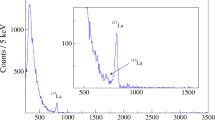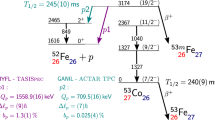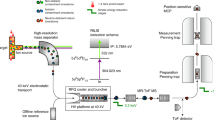Abstract
The stability and spontaneous decay of naturally occurring atomic nuclei have been much studied ever since Becquerel discovered natural radioactivity in 1896. In 1960, proton-rich nuclei with an odd or an even atomic number Z were predicted1 to decay through one- and two-proton radioactivity, respectively. The experimental observation of one-proton radioactivity was first reported2 in 1982, and two-proton radioactivity has now also been detected by experimentally studying the decay properties of 45Fe (refs 3, 4) and 54Zn (ref. 5). Here we report proton–proton correlations observed during the radioactive decay of a spinning long-lived state of the lightest known isotope of silver6, 94Ag, which is known to undergo one-proton decay7. We infer from these correlations that the long-lived state must also decay through simultaneous two-proton emission, making 94Ag the first nucleus to exhibit one- as well as two-proton radioactivity. We attribute the two-proton emission behaviour and the unexpectedly large probability for this decay mechanism to a very large deformation of the parent nucleus into a prolate (cigar-like) shape, which facilitates emission of protons either from the same or from opposite ends of the ‘cigar’.
This is a preview of subscription content, access via your institution
Access options
Subscribe to this journal
Receive 51 print issues and online access
$199.00 per year
only $3.90 per issue
Buy this article
- Purchase on Springer Link
- Instant access to full article PDF
Prices may be subject to local taxes which are calculated during checkout




Similar content being viewed by others
References
Goldansky, V. I. On neutron-deficient isotopes of light nuclei and the phenomena of proton and two-proton radioactivity. Nucl. Phys. 19, 482–495 (1960)
Hofmann, S. et al. Proton radioactivity of 151Lu. Z. Phys. A 305, 111–115 (1982)
Pfützner, M. et al. First evidence for the two-proton decay of 45Fe. Eur. Phys. J. A 14, 279–285 (2002)
Giovinazzo, J. et al. Two-proton radioactivity of 45Fe. Phys. Rev. Lett. 89, 102501–102504 (2002)
Blank, B. et al. First observation of 54Zn and its decay by two-proton emission. Phys. Rev. Lett. 94, 232501–232504 (2005)
Schmidt, K. et al. Decay properties of the new isotopes 94Ag and 95Ag. Z. Phys. A 350, 99–103 (1994)
Mukha, I. et al. Observation of direct proton decay of (21+) high-spin isomer in 94Ag. Phys. Rev. Lett. 95, 022501–022504 (2005)
Grigorenko, L. V., Johnson, R. C., Mukha, I. G., Thompson, I. J. & Zhukov, M. V. Theory of two-proton radioactivity with application to 19Mg and 48Ni. Phys. Rev. Lett. 85, 22–25 (2000)
Grigorenko, L. V., Johnson, R. C., Mukha, I. G., Thompson, I. J. & Zhukov, M. V. Two-proton radioactivity and three-body decay. I. General problems and theoretical approach. Phys. Rev. C 64, 054002–054013 (2001)
Grigorenko, L. V., Mukha, I. G. & Zhukov, M. V. Prospective candidates for the two-proton decay studies. II. Exploratory studies of 30Ar, 34Ca and 45Fe. Nucl. Phys. A 714, 425–440 (2003)
Grigorenko, L. V. & Zhukov, M. V. Two-proton radioactivity and three-body decay. II. Exploratory studies of lifetimes and correlations. Phys. Rev. C 68, 054005–054019 (2003)
Cerny, J. & Hardy, J. C. Delayed proton radioactivities. Annu. Rev. Nucl. Part. Sci. 27, 333–351 (1977)
Bochkarev, O. V. et al. Democratic decay of 6Be states. Nucl. Phys. A. 505, 215–240 (1989)
Kryger, R. A. et al. Two-proton emission from the ground state of 12O. Phys. Rev. Lett. 74, 860–863 (1995)
Gomez del Campo, J. et al. Decay of a resonance in 18Ne by the simultaneous emission of two protons. Phys. Rev. Lett. 86, 43–46 (2001)
Zerguerras, T. et al. Study of light proton-rich nuclei by complete kinematics measurements. Eur. Phys. J. A 20, 389–396 (2004)
Chromik, M. J. et al. Two-proton spectroscopy of low-lying states in 17Ne. Phys. Rev. C 66, 024313–024324 (2002)
Cable, M. D. J. et al. Discovery of beta-delayed two-proton radioactivity: 22Al. Phys. Rev. Lett. 50, 404–406 (1983)
La Commara, M. et al. Beta decay of medium and high spin isomers in 94Ag. Nucl. Phys. A 708, 167–180 (2002)
Plettner, C. et al. On the beta-decaying (21+) spin gap isomer in 94Ag. Nucl. Phys. A 733, 20–36 (2004)
Mukha, I. et al. Beta-delayed proton decay of a high-spin isomer in 94Ag. Phys. Rev. C 70, 044311–044322 (2004)
Audi, G., Wapstra, A. H. & Thibault, C. The AME2003 atomic mass evaluation (II): Tables, graphs, and references. Nucl. Phys. A 729, 337–676 (2003)
Kast, D. et al. First identification and shell model structure of 92Rh. Z. Phys. 356, 363–365 (1997)
Ohlsen, G. G. Kinematic relations of the form A + B = > C + D + E. Nucl. Instrum. Methods 37, 240–248 (1965)
Bochkarev, O. V. et al. Three-body decay of 5/2- states of 9Be and 9B isotopic doublet. Sov. J. Nucl. Phys. 52, 964–969 (1990)
Twin, P. J. et al. Observation of discrete-line superdeformed band up to 60(ℏ) in 152Dy. Phys. Rev. Lett. 57, 811–814 (1986)
Phillips, R. J. N. n-p polarization and low energy p-p phase shifts. Nucl. Phys. 21, 686–695 (1960)
Roeckl, E. et al. Recent developments at the ISOL facility of GSI Darmstadt. Nucl. Instrum. Methods Phys. Res. B 204, 53–57 (2003)
Kirchner, R. On the release and ionization efficiency of catcher-ion-source systems in isotope separation on-line. Nucl. Instrum. Methods Phys. Res. B 70, 186–199 (1992)
Lane, A. M. & Thomas, R. G. R-matrix theory of nuclear reactions. Rev. Mod. Phys. 30, 257–353 (1958)
Acknowledgements
Z.J. acknowledges support from a Polish grant. The support of the Université Catholique de Louvain, Belgium, is acknowledged by I.M. L.G. acknowledges support from the Russian RFBR and the Russian Ministry of Industry and Science. The support of the US National Science Foundation is acknowledged by S.L.T. Author Contributions R.K. was in charge of the development of the ion sources of the on-line mass separator and of the operation of this facility. I.M. suggested and built the charged-particle detector, applied the ‘tagging’ method in the data analysis and established the reported phenomenon, J.D. set up the γ-ray detectors and the related electronics and data acquisition. All authors except L.G., M.H. and P.V.D participated in the measurements. L.G. contributed the theoretical interpretation of the data. The manuscript was prepared by I.M. and E.R. with the active participation of all authors, especially J.D., H.G., M.H., S.L.T. and P.V.D.
Author information
Authors and Affiliations
Corresponding author
Ethics declarations
Competing interests
Reprints and permissions information is available at npg.nature.com/reprintsandpermissions. The authors declare no competing financial interests.
Supplementary information
Supplementary Notes
This file contains Supplementary Methods and Supplementary Figures 1–3. (PDF 700 kb)
Rights and permissions
About this article
Cite this article
Mukha, I., Roeckl, E., Batist, L. et al. Proton–proton correlations observed in two-proton radioactivity of 94Ag. Nature 439, 298–302 (2006). https://doi.org/10.1038/nature04453
Received:
Accepted:
Issue Date:
DOI: https://doi.org/10.1038/nature04453
This article is cited by
-
Nuclear shell-model simulation in digital quantum computers
Scientific Reports (2023)
-
Semi-empirical formulae for one- and two-proton radioactivity
Indian Journal of Physics (2023)
-
Two-proton radioactivity from excited states of proton-rich nuclei within Coulomb and Proximity Potential Model
Nuclear Science and Techniques (2023)
-
Two-proton radioactivity of the excited state within the Gamow-like and modified Gamow-like models
Nuclear Science and Techniques (2022)
-
Evidence of a sudden increase in the nuclear size of proton-rich silver-96
Nature Communications (2021)
Comments
By submitting a comment you agree to abide by our Terms and Community Guidelines. If you find something abusive or that does not comply with our terms or guidelines please flag it as inappropriate.



